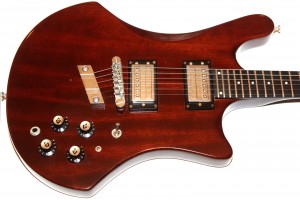
A Guild S300A-D was my only guitar for over 20 years and as a result I have a soft spot for these odd-looking beasts, so when the opportunity presented itself for me to score a 1981 Guild S300, I jumped on it. I needed to own this 1981 S300 both because I was without an S300 at the time and because I wanted to write about one of my favorite guitars which I could only do properly with one in hand. As luck would have it, the one that landed in my lap happened to be in almost like-new condition. Let’s take a look.
Introduction
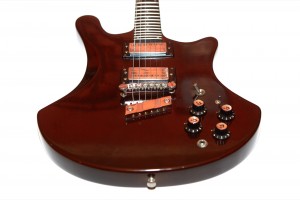
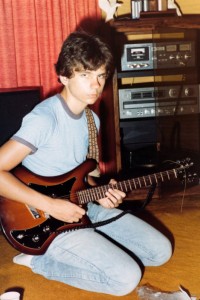
The Guild electric guitars of this era are rock machines. With its mahogany body and low-wind HB-1 pickup that guitar has a similar vibe to a Les Paul Jr., though the Junior had that P90 Mississippi Queen/Aqualung growl that that no humbucker can touch. Still, imagine a Les Paul Jr. with a Gibson PAF pickup and you’d be right about where that S60 was tone-wise.
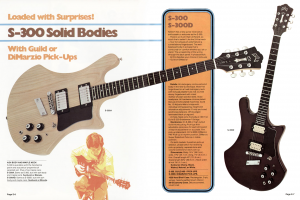
Remember, these guitars were sold in the late ’70s and early ’80s when people were pulling out those lame old “regular” humbuckers and dropping in Dimarzios, so everyone wanted that super-cool bare-bobbin upgraded look because that’s what modern guitars looked like.
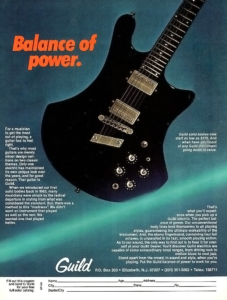
Yeah, I love these guitars.
As cool as I think these guitars are, I don’t think they ever caught on because, well, just look at the damn things. The catalog entry for the S300 calls this “the new Guild shape” which I guess is as good a name as any. It’s goofy looking in a way that worked in the mid ’70s but quickly didn’t work in a world where everyone was suddenly buying Super-Strats. That, plus the fact that no famous musicians of the time ever bought into the S300 look made these guitars have a relatively short lifespan of only a few years. That’s a shame, really, because they are great guitars as anyone who has owned one will tell you.
Finish
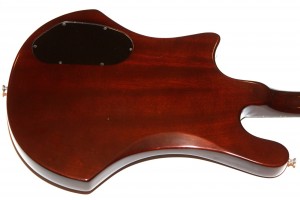
One of the things you’ll hear long-time guitarists talk about, often after looking around to see if anyone else is listening, is that they love the smell of their instruments. Lacquer has a tendency to outgas for many years after the guitar is finished and the smell of a lacquer guitar is something that we all adore. And yes, I’ll admit that when I first opened this case up at home I picked the guitar up and smelled it, and yes, it smelled great.
Available colors for the S300 were sunburst, cherry, black, walnut, natural or white while the ash-bodied versions were available in sunburst or blonde. I believe the guitar in this review to be walnut unless it was cherry and the finish faded a great deal. Sadly there is no sticker in the control cavity to confirm what the original color was but the finish inside the lip of the cavity is the same color as the outside so I’m calling this one walnut.
Fretboard and Neck
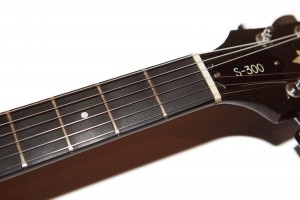
These necks are smaller than I’d prefer, but they’re deep enough to be comfortable and since an S-300AD was my only guitar for 20+ years, the neck on this guitar just feels like home. Even though I gripe about 1 5/8″ necks all the time, the S300 just feels so right that I can’t put it down. Of course I tend to be biased about all my Guilds, but the S300 is just such a great feeling guitar which is probably one of the reasons that I keep buying them.
The fretboard on this 24 3/4″ scale neck is ebony and the fret markers are simple dots. There is no binding on any S300 that I’ve ever seen and, though I love bound fretboards, this is another case where this guitar just feels right without it.
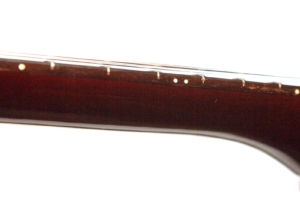
The catalog describes the fretboard as being curved, and indeed the radius measures at an almost perfect 9.5″. The frets are described in the catalog as wide and measure .10″ wide by .03″ high making them the typical Medium Jumbo fret wire seen on Guild electrics from this era.
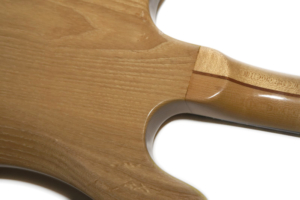
Build Quality
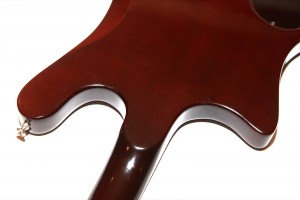
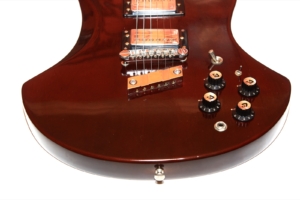
This guitar weighs a very reasonable 7 lbs 11oz. The S-300ADs that I’ve owned all felt like they weighed about 38 pounds since they were ash so this one feels nice and balanced based on my memory of those heavier guitars.
Pickups
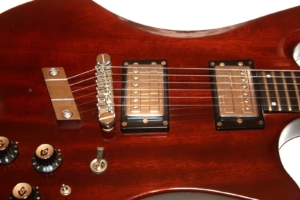
We were all after hotter, louder, and better pickups in the early ’80s, so a lot of these guitars shipped with Dimarzios installed which was great for the time. This guitar has the HB-1s in it and they are as great as they are every other time I’ve gushed about them. I also think that they’re a better choice because the Dimarzio options can be darker than the nice bright HB-1s.
This is my first S300 with HB-1s and after one strum I found myself wishing that I’d had these pickups in all my S300s, but then I wouldn’t have looked as cool as I did in the ’80s with those sexy bare bobbins. ‘Cause, you know, that’s what was important.
Electronics
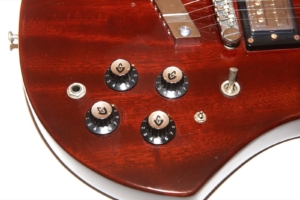
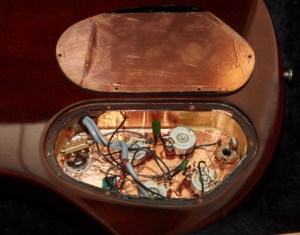
The wiring on a Guild S300 is actually pretty interesting because though it looks on the surface to be just like any other two-humbucker four-knob guitar, it’s actually not. These guitars are wired in a way that never clicked for me even after owning one for over 20 years because the difference only manifests itself in the middle position that I never used as a 20-something guitarist in the “bridge pickup or GTFO” time that was the ’80s.
On a typical two-humbucker guitar with four knobs such as a modern Les Paul, when playing in the middle position if you roll one of the volumes to zero in the middle position, the guitar will go silent. This is the case on my 1997 Guild Bluesbird and my 1998 Starfire as well, but this does not happen on a Guild S300. Why? Because of the wiring.
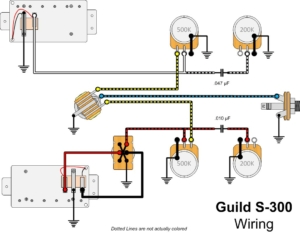
Decoupled wiring is cool because each volume control is more useful in the middle position, but the problem with decoupled wiring is that the tone darkens considerably when the volume is rolled down.
Another thing that stood out to me when I looked at the components is the fact that there are 200K pots for tone. Additionally, while there is a fairly standard .047µF capacitor on the neck tone pot, there is a tiny .010µF capacitor on the bridge tone pot. A lower resistance pot generally makes a trebly pickup sound darker and a smaller valued capacitor generally means less treble rolled off as the pot is turned down, all of which combines to make me wonder if the engineers where trying to fatten up the tone of the HB1 pickups a bit.
Hardware
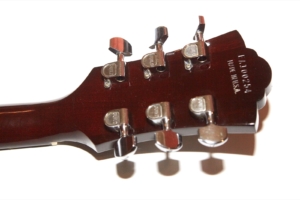
According to the catalog, all hardware is chrome plated and as you can see from the pics, this example is still in exemplary condition with the only hint of wear to the plating appearing on the selector switch which almost looks nickel in comparison to the bright shiny chrome on every other piece of hardware.
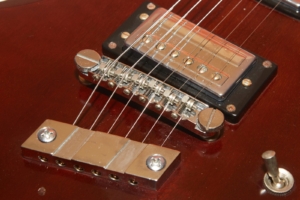
The tailpiece is solid brass according to the catalog, and is “firmly anchored” to the guitar. I’ve always felt that these S300s were sustain monsters and it wouldn’t surprise me if these blocks of brass are a big reason why.
Sound
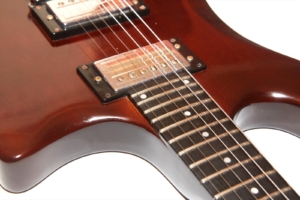
Tiny Tweed
D-Shape
E-Barre
Open Chords
JCM 800
A-Barre
Backline
D-Shape
Angry 800
E-Barre
Riff
For these recordings I used my normal Axe-FX Ultra setup through the QSC K12 speaker recorded into my trusty Olympus LS-10. As usual, three of the recordings are through the Tiny Tweed patch, though I also added a recording through the JCM-800 and one through a pretty hair-band setting called Backline. I added another to the group from the patch called Angry 800 which is basically a JCM 800 with a TS-808 and a cocked wah in front. I just fell in love with this guitar on this patch, and I loved it on every pickup selection. This guitar through a cranked amp is something to behold, and I think it’s that magic combination of great low-wind pickups in a slab of mahogany that just rocks.
This is a surprisingly versatile guitar with HB1 pickups because it can deliver great clean tones on the neck pickup all the way through the tonal spectrum to raunchy overdriven tones on the bridge. Of course, it can’t nail that single-coil tone and it can’t quack like a Strat, but I have so much fun playing it cranked that I really couldn’t care less about what it can’t do because I’m having far too much fun enjoying what it does.
Playability
As stated earlier, these guitars have smaller 1 5/8″ necks but the necks are a bit deeper than some of the 1970s Guild electrics I’ve owned, so they’re very comfortable to play. The 24-fret neck coupled with the guitar’s design makes the neck seem very long when standing, and I find myself sometimes getting a little lost if I’ve spent a lot of time with some of my Starfires because the frets aren’t always where I think they should be.
Upper fret access is ridiculously good because of the design of the guitar, and with the 24-fret neck I can hit notes I only dream of on other guitars. Since the fretboard has a pretty curvy 9.5″ radius, playing open chords is a delight which is one of the reasons I think that I like the way this guitar plays even with its smaller neck width.
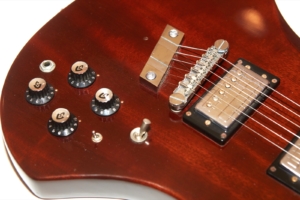
About the only gripe I have with the layout is the fact that the output jack is on the top which means that either the chord sticks out perpendicular to the top or I buy cables with right-angled plugs. I have always had an irrational dislike of right-angled plugs, probably because I need ’em when I don’t have ’em and have ’em when I don’t need ’em, so I have always just tolerated the straight plug sticking out of the top of my S300s.
Thanks to the uncoupled wiring design, the middle position on this guitar is a bit more useful than other similarly equipped guitars, at least in my opinion. I would imagine others agree because there are a fair number of websites out there describing how to alter Les Pauls to migrate to the decoupled wiring layout.
Conclusion
These are fantastic guitars and the only thing people generally dislike about them is the shape, but for me the shape is part of the appeal. I mean, how many distinctive guitar shapes are there? When I see one of these I know immediately that it’s a Guild and I know that it’s one I’ll like.
With it’s cool decoupled wiring and HB1 pickups, this guitar is a tone machine that is right at home with crunch or high gain while also producing some very nice clean tones. With four octaves of fretboard and amazingly good upper fret access, this is a guitar that was made to rock.
Devoid of many of the flashier attributes such as neck binding, elaborate inlays, carved tops, or gold hardware, this is basically a slab of mahogany with killer pickups which is always a great combination.
While most Guild electric aficionados tend to gravitate towards the S-100, or the Bluesbird, those guitars look like they’re trying to steal buyers from Gibson, and with good reason. An S300, though, is 100% pure Guild and is unapologetically its own thing. For me, an S300 is a must-have, especially when I can find one that’s this clean. As time goes on these guitars will become harder and hard to find, so if you’ve ever thought about owning one, now’s the time. You just can’t have this one. This one’s mine.
Donate: PayPal Crypto:
ETH: 0x0AC57f8e0A49dc06Ed4f7926d169342ec4FCd461
Doge: DFWpLqMr6QF67t4wRzvTtNd8UDwjGTQBGs

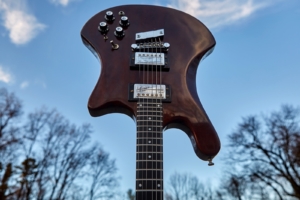
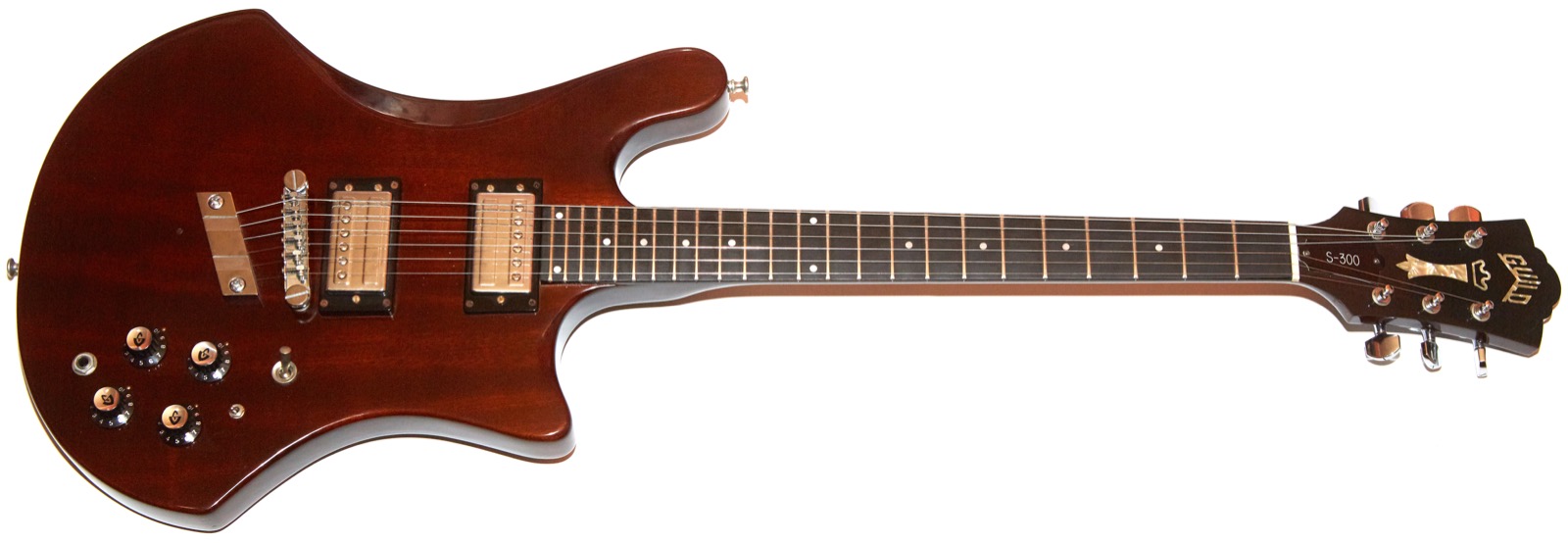
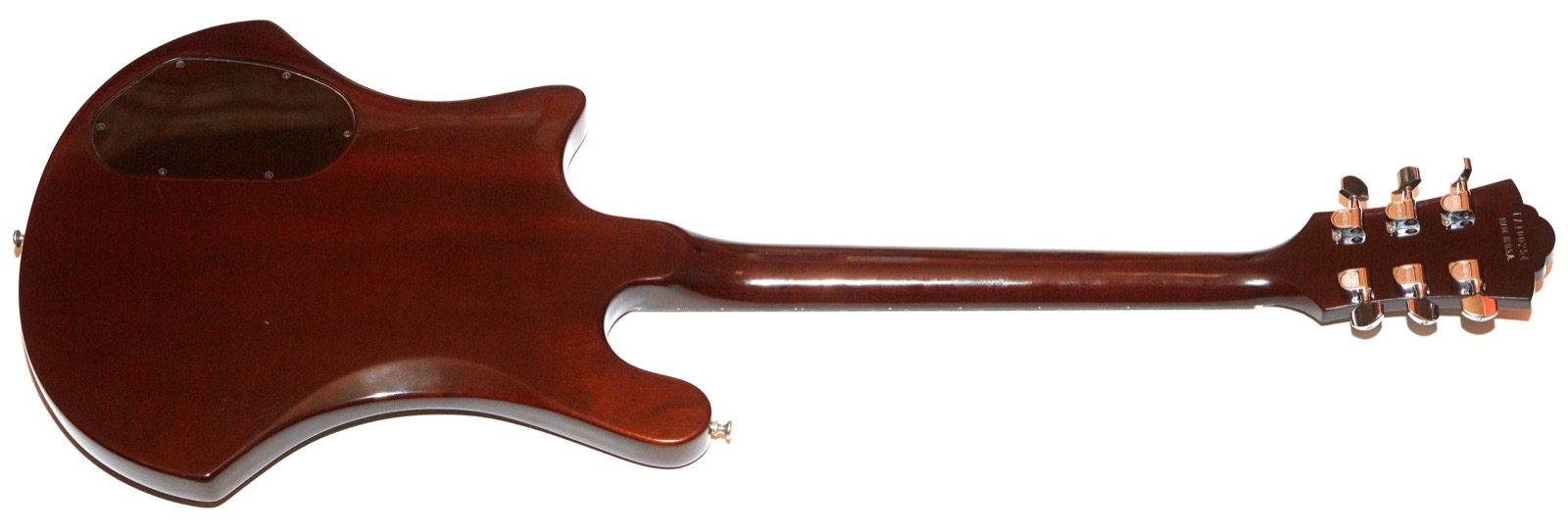
I’ve got a 1978 S300-D that I’m thinking of selling.
Any interest?
Did you ever sell it? I’m looking for one.
Hi Mark. Did you have ever get the S300D? I’ve got an early model that I’m looking to sell. Jim.
Hi
I was playing an S300D when I started playing in bands (back in 79).
And I totally agree about the absolute faboulous playability and the sound of this wonderful – a bit odd looking – guitar.
And then 1980 I got in the “Music shop” in Munich hold of a S400AD (a prototype as I was told).
The guitar looks like the S300, but the electonics is completly different (I postet it on http://www.guitar-list.com/guild/guild-s-400/eb100022 if you want to have a look)
Now the odd thing is that not many people know about the S400 and I try to get as much information together as possible.
Have you ever heard, seen or even encountered an S400 ?
Thanks for your feedback
Best regards from Germany
Hello and thanks for the comment!
The only S400 I’ve personally seen or even heard of is the one you have which I have seen from my many Internet searches regarding Guild guitars.
Your best bet for information would be Hans Moust at https://www.guitarchives.nl/guitarsgalore/
If you ever decide to sell this guitar, please do let me know!
I just wanted to update you that I was looking through my price guides and noticed that the Sept 1980 and March 1981 Guides *both* show the S400 and S400A guitars in them! No pics, but the descriptions are:
S400: Same basic guitar as the S300 series but with full electronic EQ and special hardware, laminated-type body. $875 (1980) / $925 (1981)
S400A: Same as S400, but blonde ash body. $875 (1980) / $925 (1981)
Note that the guitar was significantly more expensive than the S300A which had a price of $635 in 1981
Yours is still the only one I’ve ever seen.
Hi
Thanks for the feedback – and I will have a look at Guitarsgalore 🙂
I have to say that I own 3 electric guitars but the Guild I can’t imagine to ever let go.
I also play a Godin LGXT and a Godin ACS SA (electric guitar with nylon strings), both natively with Roland SynthAccess, but the Guild is my preferred baby.
I have no idea what the switches officialy named like – I just realize the sound effect that they create – and it is amazing how versatile the guitar is (from very bright to pretty strong distorted everything is possible).
It has the DiMarzio but due to the active electronics it can sound like a single coil (maybe one of the switches is making it single coil – I don’t know)
And yes – if (!) I ever plan to sell it I will letr you know – but I think this will never happen (except may be if I loose a hand)
Regards
Rob
Excellent article! I still have my S300-AD. Bought it back in 1980 (it is a 79) The one thing I did do to it (and believe me i wore out about 500 pairs of shoes, kicking myself in the ass) is that I mad a clear pick guard. I had the original for years, then it broke, then i lost it! GRRRRRR!!!!
Do you know where I can get one?
Thanks!
For parts you can try these guys:
Ken Nash: https://www.theguitarmechanic.com/parts.html
Hans Moust: https://www.guitarchives.nl/guitarsgalore/
I got two of these bad-boys, left-handed: S300 A-D blonde and a black S300D, Bought them new around 1978-1980, The A-D is one heavy bitch and was my main guitar when I was gigging. I eventually replaced the bridge pickup with a Lawrence.
Nice guitars,
Lefties Unite! Our numbers are small, but our Left hands are mighty!
Mark,
You looking to buy a 1979 S-300; Cherry Red – Left Handed…
I used it from 79-82..Almost new still in the original case…
Hi there, I just might be! Do you have any pics? Feel free to email me a kyleczgraham@yahoo.ca
Great assessment of this forgotten gem. I own two of these. One is a 78 black S-300 with HB-1 & the other is an 81 tobacco sunburst S-300 D. I have also recently put a pair of HB-1 in place of the DiMarzio set which is just a much better sounding pickup overall. I get why Guild went with the DiMarzio pickups for the name recognition and popularity in the late 70’s, but the HB-1 has a more unique tone ad suits my needs far better. I personally get my HB-1 wax potted as I play really loud with all types of fuzz & overdrive pedals. They still have plenty of chime,but way less squeal.
The weird shape always made me averse to owning one, but I play both S-300 guitars far more than I play my 76 S-100 which is a really great guitar.The S-300 were made for playing lead and shredding. The ebony fingerboard and access to 24 frets really give the ability to play stuff I could never think of on my various Telecasters which are my other main love. I can hardly put my 81 down as it is one of the best guitars I have ever owned. Even though body isn’t too visually appealing, they are so well balanced. They are kind of perfect marriage of a Les Paul, an SG & a Strat. I would love to score an S-70 D as well.
Came across this fun write up and it was nice to see this guitar get some recognition. I bought an S-300 AD in 1995 for about $250. I’ve dragged that guitar around the country everywhere I’ve gone for the last 20+ years and I’ve always felt there was something special about it. The fretboard or even the odd shape (it’s true, it’s comfortable). It hasn’t been my main guitar for over a decade but I’m actually picking it up from the shop today and excited to get this guitar back into rotation.
I was searching for info on the s300 and found this.
Very helpful.
There was an ebay action for a “1983” s300 “rare” white sparkle. ( I haven’t seen any others in Sparkle White)
It can still be seen using:
Advanced Search
382522769973 (listing number)
[X ] Completed listings
Lots of pics.
The s/n is EA100470 . The “Date your Guild” page has no #’s for 1983 and 2 for 1983.. EA100470 is the last
number listed.
I thought that was interesting.
Thanks for the insightful reviews.
Brian
Thanks! I have my doubts that the sparkle white finish is original. I’d like to see the inside of the control cavity cover. As for serial numbers, email Hans Moust who is the only reliable source of S/N information.
I have owned a Guild S-70 electric for 25yrs! A Lefty too! I have it at a luthier right now contemplating a refret because I love that guitar. Anyhoo, I was looking around for brand new workhorse guitar and found a used S-300 Lefty in great shape with HB1 pickups online. I had a choice between a new Mexi tele or a new low end les paul like a faded but I bought the S-300 without much hesitation. I can’t believe I found one in left and I am excited like a kid that it will be in my hands very soon! Did I make the right choice guys?
Hell yes you made the right choice! That Guild is a better-made guitar than either of those other choices! BTW I have an S70 sitting here waiting its turn to be reviewed.
Ohhh Man! Now you got me going about my favorite guitar ever….Elvira the S-70 Lol. Who better to share this with than you guys. I was 20 and pretty much an acoustic player but I definitely wanted an electric. I went in to a local shop with my friend and the usually empty Left Handed section had a very strangely shaped black beast in lefty! After getting the ”Go ahead man” nod from the guy at the counter I picked it up. Not a new guitar but the build quality was so far beyond the guitars I had handled it was crazy! All black, chrome stopbar tail piece that looked like a Razor Blade and a lightning bolt had a baby, 2 aged cream single coils in the neck and middle and a seymour duncan hotrails mini HB in the bridge. all mahogany with that long 24 fret slim neck that has a bit of depth. Someone had obviously gigged and enjoyed it before me but after plugging in and being gobsmacked by the variety of tones I got playing with the phase and bypass switches and the 5way strat style switching I had to buy it! I ripped off a Floyd solo then I paid $450 of my hard earned Canuck dollars for her and I have loved the guitar ever since! It was the electric I learned my first licks on, it can rip blues, rock, I play it clean all the time and it pulls off a mean ”Rain Song”. after trying a bunch of guitar models I realize that for me nothing with ever feel as right as my uniquely shaped relic from the past. I literally just brought my S-70 to a great tech 5 days ago to give it some t.l.c and a friend contacted me and told me he just saw a guitar like mine for sale. I paid a fair sum for this S-300 but it is the same build and materials and I think the same year as my S-70 and it looks to be in amazing shape for a 38yr old lady! Even the paint on these guitars has aged in that cool way that gives it amazing character. I think there are a ton of great guitars out there, but I have a pair of old school Guild USA electrics, 1 with single coils, one with Humbuckers, they are and will forever be my Weapons of choice. Nice to find others that enjoy these music machines.
I look forward to your review of the S-70 Gary. Be careful with it, it can’t be replaced without a time machine! The craftsmen that built these old Guild guitars really took pride in what they were doing. They were built to last.
Well, I just found this blog and the comments tonight after I just played one…well sort of…at a local Music Store. From what I’m gathering it’s a S-300D (two HB’s with DiMarzio’s). It’s a 1977 model and it’s a WELL played players guitar. Lot’s of blood, sweat and tears seem to have occurred with it based on the wear. However, as I said at the start…I sort of played it. It was near closing for the music store and I only had about 5mins with it unplugged. BUT BOY did it ring out loud and for me had near perfect neck profile. I’m a chord/rhythm player btw. So tomorrow I will be back to put that sucker on my card and take it home for a spin! I will report back my experience! I really hope I don’t like it cause it’s expensive for me at nearly $900! It sure did impress me enough so far unplugged though, and there is no hassle return policy so…
Nice! Offer ’em $750. The guitar market has dropped and I’d expect a near-mint example for $900!
I have a box stock original sunburst 300A hanging on my wall just to the right of me. Next to my 61 starfire 3 with guild single coil pickups.
Love em both and never will I part with them.
Hi there, could anyone please help me out with dimensions on this guitar?
looking for a length from base to start of fretboard, and width at the widest section of the body.
Any help would be greatly appreciated.
Regards
Dave
Also a thickness measurement of the body please?
I played this awesome guitar in many bands from around 1979- 1999. Best guitar I ever had. By far. The price to buy one again … just to own it … is too much. Around $1000 for a good one. But, eventually, I’ll replace it.
I Love the S300s. I’ve been playing an S300AD for years now. The only time I’ve seen one pop up on record is on the inner sleeve photo of Queen’s Jazz album. The studio shot. Look over to the right side in front of the gong and amongst the acoustics and Fenders, perched on a stand, there is an S300AD.
I’m adding that tidbit to my soon to be released S300AD review – thanks!
…sorry, I meant “…left side in front of the gong…”
Yes GAD, that is a walnut finish as I have the same color with the label on the cavity cover of my 1979 S-300 left handed. I guess they made more lefties than I thought according to the comments :). Had mine for about 11 years and while its not my main guitar, I always thought it was unique and as everyone knows here, well built. I did do a few mods such as putting in Seymour Duncans (JB and Jazz) with switching for humbucker, single coil and parallel, so may have compromised the originality – but super versatile and so many tonal options.
…And I totally agree with your comment on playability about getting lost where you think the frets should be 🙂
I’ve been keeping an eye out for one of these for a while. I just saw an S300-D come up for a sale a few hours from where I live. The The pics didn’t look quite right. The truss rod cover does say S 300-D, but the pickups have covers. They also don’t look like the H1-B pickups. I’m wondering if someone replaced the original Dimarzios at some point, or *gasp* put covers on the picksup? Were there any D models that had pickup covers?
The S300D came with a ’59 (PAF) and a Super Distortion, and so far as I know back then DiMarzio didn’t make them with covers (none shown in my DiMarzio ’78 catalog). My guess without seeing the guitar is that the pickups have been swapped.
Thanks. That was my thought, as well. I poked around and it looks like Dimarzio doesn’t make covers for those pickups, but some people have put covers on them. Seems like that’s a big hassle.
Great guitars, I had a 78 S 300D & hate myself for selling it, I intend to get another one when I sell a house I have, Ebony fret board, great hardware & pickups, poor man’s Gibson. I had a 73 Guild F-50 acoustic jumbo & it as well had an ebony fret board, now worth a smooth 4 to 5 Thousand, I don’t know if I will get one back like that but their acoustics ain’t nothing to laugh at.
Great article & thought into this era of Guild, like you I’m partial to this model & just discovered the GUILD M-80 double cutaway, wouldn’t mind trying one of those out, even though I play Fender & Gibson, Guild has a special place in my heart & always will.